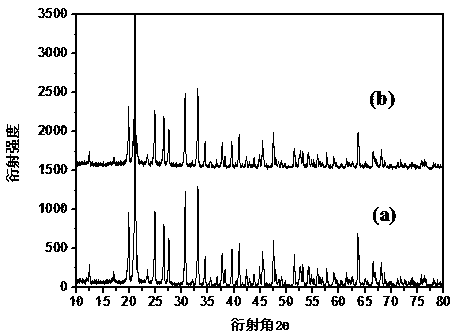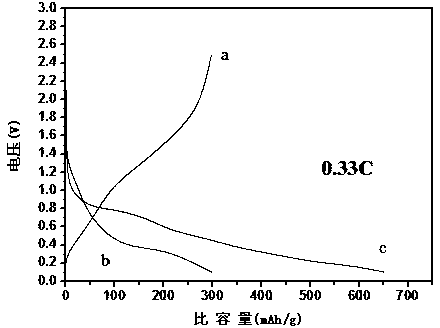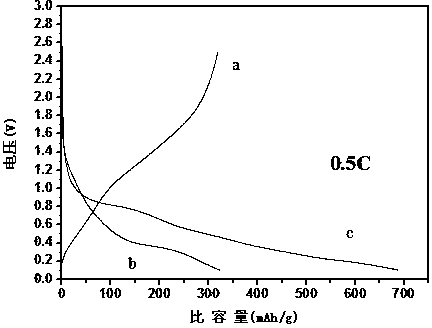Lithium molybdate cathode material for lithium ion battery and preparation method thereof
A technology of lithium ion battery and negative electrode material, which is applied to battery electrodes, non-aqueous electrolyte battery electrodes, secondary batteries, etc., to achieve the effect of simple preparation
- Summary
- Abstract
- Description
- Claims
- Application Information
AI Technical Summary
Benefits of technology
Problems solved by technology
Method used
Image
Examples
Embodiment 1
[0043] Will Li 2 CO 3 and MoO 2 Weigh it according to the stoichiometric ratio (molar ratio) of Li:Mo=2:1, grind it in an agate mortar for 30min, and mix well;
[0044] Then in the air atmosphere, heat up to 200 ° C for 4 hours of heat preservation pretreatment, and then grind again after natural cooling;
[0045] Then sinter in air at 500°C for 24h to obtain lithium molybdate (Li 2 MoO 4 ) anode material.
[0046] The XRD pattern of the product is shown in figure 1 (a), as can be seen from the figure, using this solid-state sintering method, a pure-phase trigonal lithium molybdate (Li 2 MoO 4 ) negative electrode material, there is no impurity peak in the spectrum, and the product has high purity. The lithium molybdate (Li 2 MoO 4 ) The negative electrode material is in the voltage range of 0.1~2.5V, and the rate is 0.33C and 0.5C respectively. The first charge and discharge and the second discharge curve are as follows figure 2 , image 3 As shown, the cycle per...
Embodiment 2
[0049] Will Li 2 CO 3 and MoO 3 Weigh according to the stoichiometric ratio of Li:Mo=2:1, add Li 2 CO 3 and MoO 3 The total mass of the precursor is 10wt% citric acid as a carbon source, and the raw material is ball milled in a planetary ball mill for 5 hours;
[0050] Under Ar gas atmosphere, heat up to 250°C for 5 hours of heat preservation pretreatment, after natural cooling, ball mill again;
[0051] Sintering was carried out at 550 °C for 15 h under Ar gas atmosphere to obtain carbon-coated lithium molybdate (Li 2 MoO 4 ) anode material.
[0052] The XRD pattern of the product is shown in figure 1 (b), as can be seen from the figure, using this solid-state sintering method, a pure-phase trigonal lithium molybdate (Li 2 MoO 4 ) negative electrode material, there is no impurity peak in the spectrum, and the product has high purity. The lithium molybdate (Li 2 MoO 4 ) The negative electrode material is within the voltage range of 0.1~2.5V, and the rate is 0.25C...
Embodiment 3
[0054] CH 3 COOLi and (NH 4 ) 2 MoO 4 Weigh according to the stoichiometric (molar ratio) ratio of Li:Mo=2:1, ball mill the raw materials in a planetary ball mill for 10 hours, and mix well;
[0055] Then, in an air atmosphere, heat preservation pretreatment was carried out at 300 ° C for 6 hours, after natural cooling, acetylene black accounting for 5 wt% of the sample mass after cooling was added, and ball milled again;
[0056] in N 2 sintering at 650°C for 12 h in an air atmosphere to obtain carbon-coated lithium molybdate (Li 2 MoO 4 ) anode material.
[0057] The XRD pattern of the product is shown in Figure 7 (a), as can be seen from the figure, using this solid-state sintering method, a pure-phase trigonal lithium molybdate (Li 2 MoO 4 ) negative electrode material, there is no impurity peak in the spectrum, and the product has high purity. The lithium molybdate (Li 2 MoO 4 ) The negative electrode material is within the voltage range of 0.1~2.5V, and the ...
PUM
 Login to View More
Login to View More Abstract
Description
Claims
Application Information
 Login to View More
Login to View More - R&D
- Intellectual Property
- Life Sciences
- Materials
- Tech Scout
- Unparalleled Data Quality
- Higher Quality Content
- 60% Fewer Hallucinations
Browse by: Latest US Patents, China's latest patents, Technical Efficacy Thesaurus, Application Domain, Technology Topic, Popular Technical Reports.
© 2025 PatSnap. All rights reserved.Legal|Privacy policy|Modern Slavery Act Transparency Statement|Sitemap|About US| Contact US: help@patsnap.com



